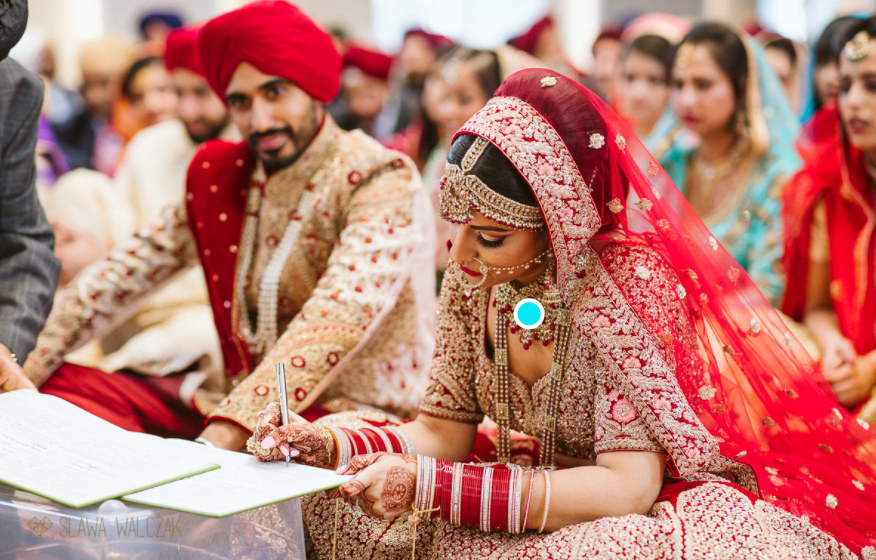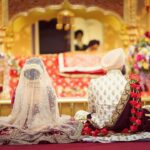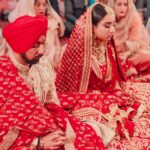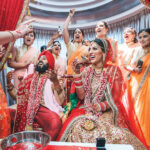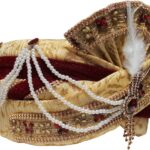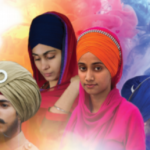The ‘Anand Karaj’ Sikh marriage ceremony has been recognised by the Indian government since 1909. ‘Blissful Union’ is the literal translation of Anand Karaj. The ceremony is held during the day or in the afternoon at the Gurudwara prayer hall. The Guru Granth Sahib is placed in a prominent location, and the wedding ceremony is built around it. The bride and groom sitting side by side, with the bride on the groom’s left and facing the Guru Granth Sahib. You must embrace the religious ideals of the Sikh wedding as well as institutions such as the Sikh temple and the Gurdwara. Covering your head, not wearing shoes on religious grounds, and dressing modestly are all examples.
Let’s explore more regarding what to wear in a Sikh wedding ceremony:
Turban
When participating in any Sikh events, a typical Sikh would wear his turban. This is the most important feature that distinguishes a Sikh from other religions. The turban gives the Sikh community a distinct identity. A turban will keep your head protected at all times. It encompasses one’s honour, spirituality, piety, self-respect, courage, and equality, as well as their Sikh faith. The turban is one of Sikhs’ five K’s, which stands for uncut hair (kesh). The only thing to remember is to never adorn a black or white turban, as these colours are reserved for Sikh funerals.
Handkerchiefs
Wearing a handkerchief to a Sikh wedding is a good and easy choice, especially for Sikhs who have chopped their hair and for non-Sikh wedding guests. Handkerchiefs are not suited for ladies; they are only appropriate for guys. Before entering the Gurdwara, a handkerchief is usually provided at the front. The main thing to keep in mind is that these handkerchiefs are used by a range of people at different times of the day. It is recommended that you bring your own for hygiene reasons. Make more absolut handkerchief is big enough to tie a knot at the back. During the festivities inside the Gurdwara, make sure you keep your handkerchief on.
Caps
For both Sikh and non-Sikh guests, donning a cap to a Sikh wedding appears too informal and irreverent. Wearing a cap to the Gurdwara is strongly associated with captivity, loss of dignity, and apostasy for Sikhs. When you look into and research Sikh fiction, historical traditions, and art, you’ll notice this. Sikh weddings are always quite formal affairs, and wearing a cap would not only be frowned upon but will also make you seem and feel out of place. Wearing a cap is not considered formal wear.
Outfit
Regardless of whether you are a male or female visitor, you should never show up to a Sikh wedding wearing shorts of any length. Legs should never be exposed. Wearing see-through clothing or exposing too much of your midriff is not a good idea. Sikh weddings are always exciting and colourful affairs. You can wear any colour you choose and be as brilliant and bold as you like. The only thing to keep in mind is that you should never wear black or white apparel. In the Sikh community, these two hues are always associated with colours to wear to funerals. For girls, a suit and kurta pyjama would be an excellent alternative.
Sikh weddings include a variety of functions, and it is up to the family to decide how many of the customary rites they want to participate in. A few of these gatherings would be less ceremonial than others, and they may take place at the family’s residence. A hall could be used for some of the grander, more elaborate ceremonies. Because all of the ceremonies are family-oriented, you must dress respectfully, not only for the family but also for their values.
To all of the festivities, Sikh ladies would often wear traditional costumes. Apart from the marriage day, you might wear less formal and decorative clothing. You must, however, maintain and follow the restrictions prohibiting the wearing of black or white clothing. You would not be compelled to cover your head on the majority of these instances. Although, as with all traditional garments, yours will have a chunni (long scarf) that may be thrown over your back to ensure that you are always ready to cover your head if necessary.
Engagement
The Roka is the first stage and the beginning of the Sikh wedding ceremony. The exchanging of engagement rings represents not only the unification of the two families but also the couple’s devotion to each other. In comparison to the other traditions, the Roka is usually a low-key fair held at the bride’s family home. It includes both sides’ intimate family members, as well as maybe very close family friends.
Traditional clothing such as churidar and salwar kkameezesare the most common. Non-Sikh visitors are welcome to dress in western attire. In terms of dressing, you must be very conversant.
Appropriate colour of attire
It is customary in Sikh culture to dress in bright and cheerful colours for such events. Bright reds, vibrant blues, deep green, and a big blend of these and other colours will be seen among the females. Although it is preferable to avoid wearing pure white and black at religious ceremonies when nothing is sacred, you may feel out of place in other settings.
Bright colours are unquestionably the most auspicious at Asian weddings, but pastels are still appropriate, particularly in the summer. Avoid wearing bright red because it is intended for the bride, and you don’t want to overshadow her on her big day!
Gifts
Unless you are a very close relative, it is not customary for visitors to bring gifts for the Bride and Groom. After the religious ceremony, there is a “Sagan” ceremony in which the majority of the visitors give money to the newlywed couple.
The modern alternative is to put the money in a congratulation card and deliver it to the mother of the bride or groom, based on who invited you to the marriage. Unless you go the latter method, you’ll have to queue at the end of the religious service to offer the bride and groom the saga.’
